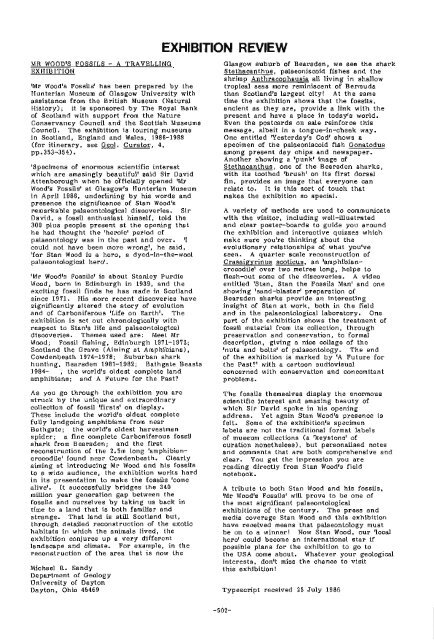here - Geological Curators Group
here - Geological Curators Group
here - Geological Curators Group
- No tags were found...
Create successful ePaper yourself
Turn your PDF publications into a flip-book with our unique Google optimized e-Paper software.
MR WOOD'S FOSSILS - A TRAVELLINGEXHIBITION'Mr Wood's Fossils' has been prepared by theHunterian Museum of Glasgow Universitv withUassistance from the British Museum (NaturalHistorv): it is sponsored by The Royal Bankof coila and with support from the ~atureConservancy Council and the Scottish MuseumsCouncil. The exhibition is touring museumsin Scotland, England and Wales, 1986-1988(for itinerary, see m. Curator, 4,pp.353-354).'Specimens of enormous scientific interestwhich are amazingly beautiful' said Sir DavidAttenborough when he otficially opened 'MrWood's Fossils' at Glasgow's Hunterian Museumin April 1986, underlining - bv - his words andpresence the signif~cn~~cc of Stan \Voodlsremarkable pnlaunntologio~l discoveries. SirDavid. il Fossil enthusiast himself, toll1 thc300 people present at the opening thathe had thought the 'heroic' period ofpalaeontology was in the past and over. 'Icould not have been more wrong', he said,'for Stan Wood is a hero, a dyed-in-the-woolpalaeontological hero'.'Mr Wood's Fossils' is about Stanley PurdieWood, born in Edinburgh in 1939, and theexciting fossil finds he has made in Scotlandsince 1971. His more recent discoveries havesignificantly altered the story of evolutionand of Carboniferous 'Life on Earth'. Theexhibition is set out chronologically withrespect to Stan's life and palaeontologicaldiscoveries. Themes used are: Meet MrWood; Fossil fishing, Edinburgh 1911-1912;Scotland the Grave (Aiming at Amphibians),Cowdenbeath 1914-1978; Suburban sharkhunting, Rearsden 1981-1982; Bathgate Beasts1984- , the world's oldest complete landamphibians; and A Future for the Past?EXHIBITION REVIEWGlasgow suburb of Bearsden, we see the sharkStethacanthus, palaeoniscoid fishes and theshrimp Anthracophausia all living in shallowtropical seas more reminiscent of Bermudathan Scotland's largest city! At the sametime the exhibition shows that the fossils,ancient as they are, provide a link with thepresent and have a place in today's world.Even the postcards on sale reinforce thismessage, albeit in a tongue-in-cheek way.One entitled 'Yesterday's Cod' shows aspecimen of the palaeoniscoid fish Gonatodusamong present day chips and newspaper.Another showing a 'punk' image ofStethacanthus, one of the Bearsden sharks,with its toothed 'brush' on its first dorsalfin, provides an image that everyone canrelate to. It is this sort of touch thatmakes the exhibition so special.A variety of methods are used to communicatewith the visitor, including well-illustratedand clear poster-boards to guide you aroundthe exhibition and interactive quizzes whichmake sure you're thinking about theevolutionary relationships of what you'veseen. A quarter scale reconstruction ofCrassiavrinus scoticus, an 'amphibiancrocodile'over two metres long, helps toflesh-out some of the discoveries. A videoentitled 'Stan. Stan the Fossils Xan' and oneshowing 'sand-blaster' preparation ofBearsden sharks provide an interestinginsight of Stan at work, both in the fieldand in the palaeontological laboratory. Onepart of the exhibition shows the treatment offossil material from its collection, throughpreservation and conservation, to formaldescription, giving a nice collage of the'nuts and bolts' of palaeontology. The endof the exhibition is marked by 'A Future forthe Past?' with a cartoon audiovisualconcerned with conservation and concomitantproblems.As you go through the exhibition you arestruck by the unique and extraordinarycollection of fossil 'firsts' on display.These include the world's oldest completefullv - ~landnoina amohibians from nearS~ U .Bathgate; the world's oldest harvestmanspider; a fine complete Carboniferous fossilshark from Bearsden; and the firstreconstruction of the 2.5m long 'amphibiancrocodile'found near Cowdenbeath. Clearlyaiming at introducing Mr Wood and his fossilsto a wide audience, the exhibition works hardin its presentation to make the fossils 'comealive'. It successfullv bridges the 340million yeargap lbetween thefossils and ourselves by taking us back intime to a land that is both familiar andstrange. That land is still Scotland but,through detailed reconstruction of the exotichabitats in which the animals lived, theexhibition conjures up a very differentlandscape and climate. For example, in t<strong>here</strong>construction of the area that is now theMichael R. SandyDepartment of GeologyUniversity of DaytonDayton, Ohio 45469The fossils themselves display the enormousscientific interest and amazing beauty ofwhich Sir David spoke in his openingaddress. Yet again Stan Wood's presence isfelt. Some of the exhibition's specimenlabels are not the traditional format labelsof museum collections (a 'keystone' ofcuration nonetheless), but personalised notesand comments that are both comprehensive andclear. You get the impression you arereading directly from Stan Wood's fieldnotebook.A tribute to both Stan Wood and his fossils,'Mr Wood's Fossils' will prove to be one ofthe most significant palaeontologicalexhibitions of the century. The press andmedia coverage Stan Wood and this exhibitionhave received means that palaeontology musthe on to a winner! Now Stan Wood, our localhero' could become an international star ifpossible plans for the exhibition to go tothe USA come about. Whatever your geologicalinterests, don't miss the chance to visitthis exhibition!Typescript received 25 July 1986
















